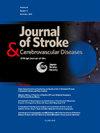伴有右至左分流的隐源性卒中患者存在白质高信号与脑血管反应性受损有关。
IF 2
4区 医学
Q3 NEUROSCIENCES
Journal of Stroke & Cerebrovascular Diseases
Pub Date : 2025-02-01
DOI:10.1016/j.jstrokecerebrovasdis.2025.108223
引用次数: 0
摘要
目的:探讨隐源性脑卒中(CS)右-左分流(RLS)患者脑血管反应性(CVR)的变化,并探讨CVR与脑白质高信号(WMHs)的关系。方法:采用屏气法测定大脑中动脉(MCA)的屏气指数(BHI), BHI代表CVR。wmh定义为3T磁共振成像(MRI)上清晰的高信号区,分别评估为心室周围高信号区(PVH)和深部白质高信号区(DWMH)。RLS的诊断是基于经颅多普勒(c-TCD)检查。结果:在260例CS患者和128例对照组中,CS组BHI明显低于对照组(0.68±0.27 vs 0.83±0.31)。结论:CS患者,尤其是RLS患者CVR明显降低,这与WMHs发生部位和严重程度有关。这些发现表明,RLS可能显著促进了CS患者WMH的发展。本文章由计算机程序翻译,如有差异,请以英文原文为准。
Compromised cerebrovascular reactivity related to presence of white matter hyperintensities in cryptogenic stroke with right-to-left shunts
Objective
This study investigates cerebrovascular reactivity (CVR) changes in cryptogenic stroke (CS) patients with right-to-left shunts (RLS) and evaluates the relationship between CVR and white matter hyperintensities (WMHs).
Methods
The breath-holding index (BHI), representing CVR, was measured from the middle cerebral artery (MCA) using the breath-holding method. WMHs were defined as clearly hyperintense areas on 3T magnetic resonance imaging (MRI), assessed separately as periventricular hyperintensities (PVH) and deep white matter hyperintensities (DWMH). RLS was diagnosed based on a contrast-enhanced transcranial Doppler (c-TCD) examination.
Results
Among 260 CS patients and 128 controls, BHI was significantly lower in CS groups (0.68±0.27 vs. 0.83±0.31, P<0.001), particularly in those with RLS (0.64±0.28 vs. 0.71±0.25,P = 0.030). CS patients with WMHs exhibited lower BHI than those without WMHs (0.50±0.22 vs.0.60±0.35, P = 0.012), and PVH showed lower BHI compared to DWMH (0.45±0.24 vs.0.58±0.16, P = 0.003). A negative correlation was found between WMH severity and BHI (0.60±0.35 vs.0.51±0.21 vs.0.48±0.20 vs.0.38±0.28, P = 0.025). Reduced BHI was an independent risk factor for WMHs (OR = 0.283; 95 % CI = 0.081-0.995, P = 0.049).
Conclusion
CS patients, especially those with RLS, show reduced CVR, which correlates with the location and severity of WMHs. These findings suggest that RLS may significantly contribute to WMH development in CS patients.
求助全文
通过发布文献求助,成功后即可免费获取论文全文。
去求助
来源期刊

Journal of Stroke & Cerebrovascular Diseases
Medicine-Surgery
CiteScore
5.00
自引率
4.00%
发文量
583
审稿时长
62 days
期刊介绍:
The Journal of Stroke & Cerebrovascular Diseases publishes original papers on basic and clinical science related to the fields of stroke and cerebrovascular diseases. The Journal also features review articles, controversies, methods and technical notes, selected case reports and other original articles of special nature. Its editorial mission is to focus on prevention and repair of cerebrovascular disease. Clinical papers emphasize medical and surgical aspects of stroke, clinical trials and design, epidemiology, stroke care delivery systems and outcomes, imaging sciences and rehabilitation of stroke. The Journal will be of special interest to specialists involved in caring for patients with cerebrovascular disease, including neurologists, neurosurgeons and cardiologists.
 求助内容:
求助内容: 应助结果提醒方式:
应助结果提醒方式:


